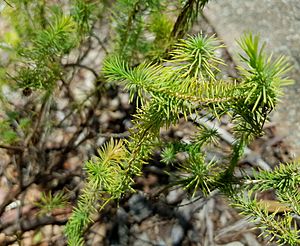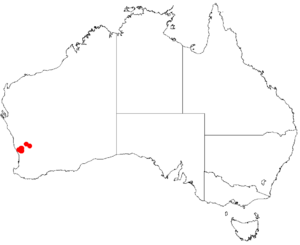Fine-leaved darwinia facts for kids
Quick facts for kids Fine-leaved darwinia |
|
|---|---|
 |
|
| Conservation status | |
| Scientific classification | |
| Genus: |
Darwinia
|
| Species: |
acerosa
|
 |
|
| Occurrence data from AVH | |
Darwinia acerosa, also called the fine-leaved darwinia, is a special plant from the Myrtaceae family, which includes plants like eucalyptus. It only grows in a small part of Western Australia, in the south-west. This plant is a bushy shrub that looks a bit like a heath plant. It has many branches, lots of thin, pointed leaves, and hanging groups of 40 to 50 yellowish-green flowers.
Contents
What Darwinia acerosa Looks Like
Darwinia acerosa is a spreading, bushy shrub. It has whitish branches and usually grows to be about 30 to 50 centimeters (12 to 20 inches) tall. Its leaves are packed closely together. They are about 1 centimeter (0.4 inches) long and very thin, about 1 millimeter (0.04 inches) wide. Each leaf is shaped like a triangle if you cut it in half, and it often has a small hook at the tip.
The flowers of this plant grow in hanging, roundish groups. Each group has 40 to 50 greenish-yellow flowers. These flower heads are about 1.5 centimeters (0.6 inches) across. They are surrounded by rows of green leaf-like parts called bracts. These bracts are longer than the actual flowers.
How Darwinia acerosa Got Its Name
The first official description of Darwinia acerosa was written by a person named William Vincent Fitzgerald. He published it in 1904 in a science journal. The second part of its scientific name, acerosa, comes from a Latin word. It means "full of chaff" or "needle-like," which describes its thin, pointed leaves.
Where Darwinia acerosa Lives
This special darwinia plant is found in only a few places. Scientists know of three groups of these plants near the Mogumber area and four groups near the city of Perth. In total, there are about 5,000 of these plants left. They grow in scrubland and heath areas, often on or around large granite rocks.
Protecting Darwinia acerosa
Darwinia acerosa is a very rare plant. The government of Western Australia lists it as "Threatened Flora." This means it is a rare plant that needs protection. The Australian government also lists it as "Endangered" (EN) under a law called the Environment Protection and Biodiversity Conservation Act 1999 (EPBC Act). This means it is at a very high risk of disappearing forever.
Some of the main dangers to Darwinia acerosa include:
- Dieback: This is a plant disease caused by a type of mold called Phytophthora cinnamomi. It makes the plant's roots rot and can kill it.
- Weed invasion: Other plants, called weeds, can grow too close to the darwinia. They can take away water and nutrients that the darwinia needs to survive.
- Grazing: Animals eating the plants can also harm the populations.
- Frequent fires: While some Australian plants need fire to grow, too many fires, or fires that happen too often, can destroy the plants before they have a chance to recover.


